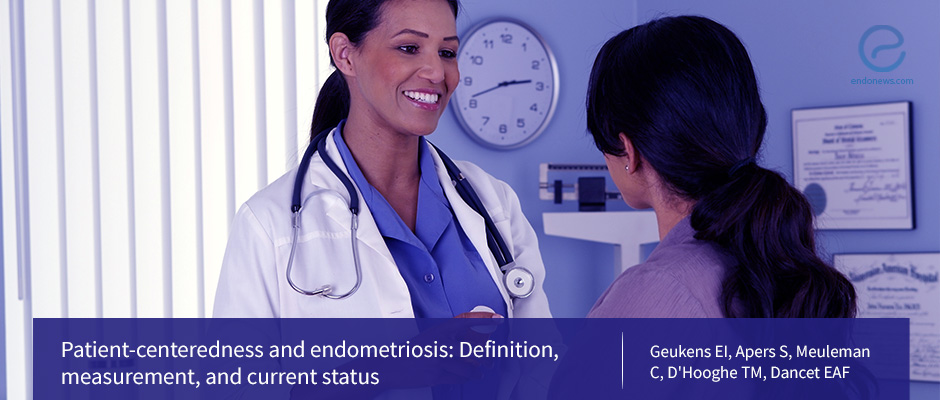Patient-centered endometriosis care
Jun 11, 2018
"Patient-centered endometriosis care" is defined by taking into consideration of the most common needs, values, and preferences of the patients with endometriosis.
Key Points
Highlights:
- This study defines the patient-centered endometriosis care (PCEC) including ten dimensions to which all endometriosis clinics should pay attention to, and also reviews the current patient-centered status of clinics based on these ten dimensions and ENDOCARE questionnaire (ECQ).
Importance:
- Women with endometriosis classically present with pain symptoms that affect the individual’s quality of life. The PCEC aims to improve health-related quality of life, rather than only physical well-being, in the management of women with endometriosis.
What’s done here?
- The authors reviewed the literature including three patient surveys and nine qualitative studies noticing the patients’ most common preferences, needs, and values.
- They interviewed 15 women with endometriosis to learn about the demographic and clinical characteristics of the patients.
- They developed PCEC using ten dimensions and the ECQ as the only valid and reliable tool to assess PCEC.
Key results:
- They present the ECQ, which is the only valid and reliable questionnaire that allows measuring the patient-centered status of an endometriosis clinic.
- The authors define PCEC by summarizing it in ten dimensions; respect for patients’ values, preferences and needs, coordination and integration of care, information, communication, and education, physical comfort, emotional support and alleviation of fear and anxiety, involvement of significant others, continuity and transition, access to care, endometriosis health-care staff and technical skills.
- The ECQ consists of three parts. Part I includes the demographic and clinical characteristics of the patients. Part II consists of women’s replies on the rate of the importance of their experiences with 38 statements on 4-point Likert scales. Part III includes two overall rating questions.
- They also inform us about the current status of patient-centered endometriosis clinics using the ECQ.
Limitations
- This study is performed in a small sample size for which demographic and clinical characteristics of the patients in ECQ assessments.
- The comparison between pre- and post-improvement project assessments is limited, as patient-centered improvement projects are not yet set up.
Lay Summary
Endometriosis is defined as endometrial glands and stroma that exist outside the uterine cavity. Ectopic endometrial tissue and resultant inflammation can cause dysmenorrhea, dyspareunia, chronic pain, and infertility, all of which reduce the quality of life. The aim of the management is generally to achieve pain relief which usually is not satisfactory for most patients and unfortunately, the recurrence rate can be as high as 40-50%. However, the goal of the treatment should be to increase the quality of life rather than the physical well-being and to provide PCEC.
In this study, published in the Journal of Best Practice and Research Clinical Obstetrics and Gynecology, a group of scientists from Belgium searched the measurement of PCEC and the patient-centered status of clinics. For this aim, they described PCEC using ten dimensions; respect for patients’ values, preferences, and needs, coordination and integration of care, information, communication, and education, physical comfort, emotional support and alleviation of fear and anxiety, involvement of significant others, continuity and transition, access to care, endometriosis health-care staff and technical skills. They developed the only valid and reliable tool named as ECQ to evaluate PCEC. They behaved respectfully and responded to individual preferences, needs, and values. The ECQ consists of three parts. Part I includes the demographic and clinical characteristics of the patients. Part II consists of women’s replies on the rate of the importance of their experience with 38 statements on 4-point Likert scales. Part III includes two overall rating questions.
They stated that respecting and believing in patients, providing information on self-care after surgery and giving consistent information, offering the opportunity to discuss daily complaints and ensuring physician continuity, limiting waiting time between diagnosis and surgery, ensuring that healthcare staff has knowledge on endometriosis and being pro-active rather than adopting a wait-and-see approach should be aims of PCEC, based on data from at least three clinics.
"All healthcare staff should be careful about all ten dimensions of PCEC in the management of women with endometriosis, comparison of one clinic to another about their patient-centered assessments will be helpful to improve their care", authors concluded.
Research Source: https://www.ncbi.nlm.nih.gov/pubmed/29580773
endometriosis patient-centeredness quality of care needs values questionnaire symptoms well-being therapy believe information reliability

